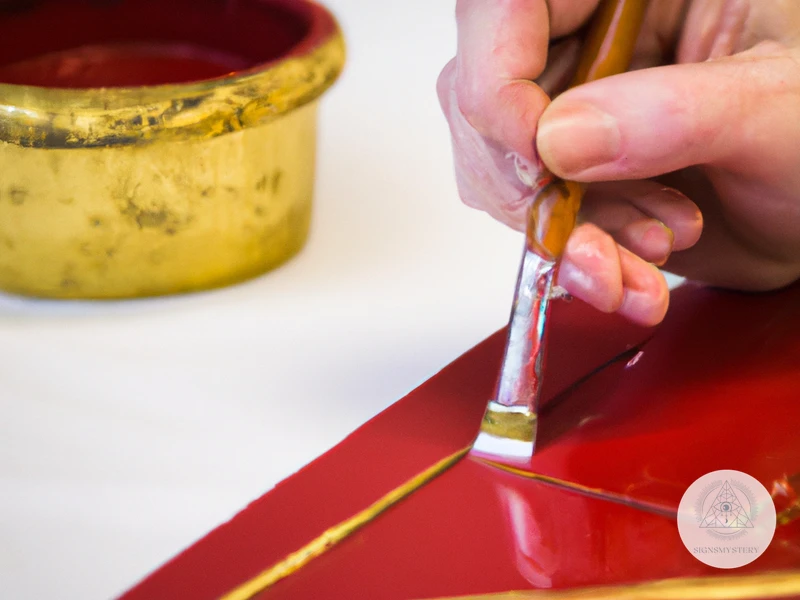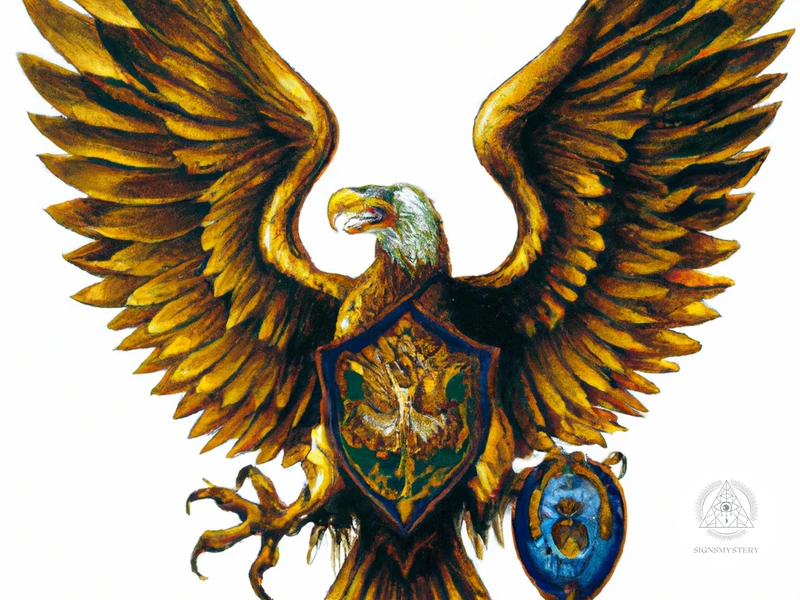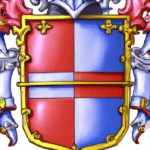The essence of one’s identity encompasses numerous things, including beliefs, values, and personality traits, among others. The creation of a personal coat of arms can be an excellent way to symbolize these aspects visually. A coat of arms is a unique design that was traditionally used to identify a family or organization. In recent years, many individuals have adopted the practice of creating their own personal coat of arms as a way to represent themselves. This article provides a step-by-step guide to creating your own symbolic self-representation, as well as some tips and tricks to aid in the process.
What is a Coat of Arms?
A coat of arms is a symbolic design that represents a family, organization, or individual. The design usually consists of a shield, helmet, and various other elements such as colors and symbols. Historically, coats of arms were used in battle to identify knights and soldiers, but today they are mostly used as a form of symbolic self-representation. Creating a personal coat of arms is a way to express core values and identify with a particular symbol or set of symbols. The design can incorporate elements of one’s heritage or personal interests, and can be as traditional or unique as desired. To learn more about the history and components of coats of arms, visit /history-coat-of-arms/.
Why Create a Personal Coat of Arms?
Creating a personal coat of arms is more than just designing a symbol to represent yourself. It is an opportunity to reflect on your core values and aspirations, and to express them through visual imagery. Your coat of arms can be a powerful tool for self-discovery and self-representation.
In addition to providing a visual representation of your personal values, a coat of arms can also be a way to connect with your family’s history and traditions. Many families have their own coat of arms, and creating your own can be a way to honor that heritage while also making something unique to you.
A personal coat of arms can also be a great conversation starter. Whether you display it on a shield, a banner, or as part of your stationary, it is sure to pique the interest of those around you. It can also be a way to stand out in a crowded marketplace or professional setting, as it showcases your creativity, uniqueness, and commitment to your values.
Designing a personal coat of arms can be a meditative process that provides a sense of accomplishment and pride. It can be a fun and rewarding exercise in exploring your own identity and expressing it through art.
In short, creating a personal coat of arms is an opportunity to reflect on your values, connect with your family’s history, stand out in a professional setting, and engage in a meditative and rewarding creative process. It is a unique way to represent yourself visually and to showcase your creativity and uniqueness.
How to Use Your Personal Coat of Arms
Your personal coat of arms is a unique symbol that represents your core values, personality, and personal journey. Now that you have created your own coat of arms, it’s time to understand how to use it in your life. Here are some ways to use your personal coat of arms:
1. Personal Branding
Use your coat of arms to create a personal brand. A consistent visual identity can help you stand out in a crowded marketplace, whether you’re an entrepreneur, artist, or job candidate. Incorporate it into your website design, business cards, and social media profiles. This will help you build a recognizable, memorable brand that sets you apart from others in your industry.
2. Family Crest
You can also use your coat of arms as a family crest to represent your family heritage and history. It can become a meaningful family tradition that gets passed down from generation to generation. Display it proudly in your home, on your family tree, or in any other way that celebrates your family’s past, present, and future.
3. Personal Finance
You can even use your coat of arms to represent your personal financial goals, such as achieving financial independence or building wealth. It can be a motivational tool that reminds you of the importance of staying focused and disciplined on your financial journey. You can add your coat of arms to your financial goals tracker or on your vision board.
4. Tattoos and Merchandise
If you love your coat of arms design and want to make it a permanent part of your body or wardrobe, consider getting a tattoo or creating custom merchandise. Your coat of arms can serve as a unique and personal piece of art that reflects your values and personality. This can be an opportunity to express yourself creatively and fashionably.
There are many ways to use your personal coat of arms, whether it’s for personal branding, family representation, financial motivation, or creative expression. It’s the perfect symbol to represent who you are and what you stand for. Find your inspiration in the famous coat of arms meanings, techniques or components, and the historical evolution of coat of arms designs, or the modern political use of the concept. Whatever you choose to do with your coat of arms, make sure it reflects your own personal journey and values.
Step-by-Step Guide

Creating a personal coat of arms requires a deliberate and carefully-crafted approach. The for creating a personal coat of arms begins by identifying core values, which form the foundation of the coat of arms. Once the core values are chosen, the next step is to select colors and symbols that best represent them. Sketching the design comes next, followed by refining it to its final polished look. Digitizing the coat of arms ensures its longevity and easy reproduction. Following these instructions will result in a unique and personal coat of arms that effectively represents its owner and their values. In designing the coat of arms, it may be helpful to consider historical symbolism. Simplicity is also recommended in the design process. Finally, getting feedback on the final choice will ensure that the design is effectively communicating its intended message.
Step 1: Identify Core Values
Creating a personal coat of arms is a reflection of oneself, so figuring out one’s core values is essential to designing a meaningful coat of arms. Core values are beliefs and principles that are integral to a person’s identity and what they stand for. Understanding one’s core values enables them to craft a coat of arms that accurately represents their character and aspirations.
To discover core values, one should reflect on what matters most to them in life. It could be anything from family to career, creativity to adventure, or honesty to loyalty. These values should be meaningful and guide the way their life is lived. A coat of arms serves as a visual representation of these foundational values.
Incorporating these values into the coat of arms can be done using symbols, colors, and mottoes. For instance, if honesty is a core value, incorporating an emblem like a pair of balanced scales can signify balance and fairness. Equally, if loyalty is at the core, including a symbol of a pelican that feeds its young with its own blood means selflessness, providing for others and loyalty.
Remember, the coat of arms should reflect and pay tribute to the bearer’s character and must have a deeper meaning beyond aesthetic appeal. Taking the time to identify core values is a crucial first step towards designing a coat of arms that is personal and meaningful.
Identifying core values is essential in creating a personalized coat of arms. It lays the foundation for the design process and ensures that the coat of arms reflects the one who bears it correctly. Reflecting on one’s values enables the designer to select the most appropriate symbols, colors, and mottoes that carry their intended meaning. The next step is to choose colors and symbols.
Step 2: Choose Colors and Symbols
Now that you’ve identified your core values, it’s time to consider the colors and symbols that will represent them in your coat of arms. These choices should reflect your personal preferences and resonate with your identity and values.
Colors: Colors are an essential element of any coat of arms, as they convey meaning and symbolism. Red represents bravery and strength, while blue symbolizes loyalty and wisdom. Gold or yellow is often associated with generosity and nobility, and green can represent hope or growth. Black can symbolize determination, and white can signify purity.
It’s important to remember that colors can have different meanings depending on cultural and historical context. For example, in Japanese culture, white is traditionally associated with death, while in Western cultures, black is often connected with mourning.
Symbols: Symbols are another critical component of a coat of arms. They can represent personal interests, family history, and values. Some common symbols include lions (representing strength), eagles (representing courage), and crosses (representing faith).
Consider incorporating heraldic elements such as shields, helms, or crowns. Or, if you prefer a more modern approach, you could use symbols such as hearts, stars, or arrows.
When choosing your colors and symbols, keep in mind the overall aesthetic of your design. You want your coat of arms to be visually appealing and reflect your personality.
It’s also essential to avoid using copyrighted or trademarked symbols in your coat of arms, as this could lead to legal issues down the line.
Once you’ve chosen your colors and symbols, make a list or table to keep track of them. This will ensure that you stay organized throughout the design process and have a clear vision for your coat of arms.
Remember, your coat of arms is meant to be a reflection of who you are and what you stand for. So take the time to choose colors and symbols that truly resonate with you.
Step 3: Sketch Your Coat of Arms
Step 3: Sketch Your Coat of Arms
Once you have identified your core values and chosen the colors and symbols to include in your coat of arms, it’s time to start sketching your design. Grab a piece of paper and a pencil, and begin to play around with different layouts and arrangements of your chosen elements.
Don’t worry if your sketches aren’t perfect at this stage – the purpose of this step is to get all of your ideas onto paper so you can refine them later. Experiment with different sizes and positions for each symbol, and try out different color combinations to see what works best.
When sketching your coat of arms, it can be helpful to keep in mind the principles of heraldry, the ancient art of designing and interpreting coats of arms. Heraldry includes specific rules for the placement of symbols and colors on a coat of arms, so incorporating these principles can give your design a more traditional or historically accurate look.
Remember to think about the overall message you want your coat of arms to convey, and make sure your symbols and colors align with your core values. Your coat of arms should be a symbolic representation of your identity and what is important to you.
Once you have a few sketches that you’re happy with, let them sit for a day or two before moving on to step 4. This will give you some time to reflect on your designs and make any necessary tweaks or revisions before refining your design.
By following these steps and taking the time to sketch out your ideas, you’ll be on your way to creating a unique and meaningful personal coat of arms that accurately represents who you are and what you stand for.
Step 4: Refine Your Design
During Step 4, it’s time to refine your design and ensure that it aligns with your core values and symbolism. Begin by reviewing your rough sketch and making any necessary adjustments. Consider the scale of the different elements, their placement, and their overall balance within the shield.
Next, think about the colors you selected in the previous step and how they work together. Are there any changes you need to make to enhance the contrast or help different symbols stand out? Remember that color is a powerful tool in visual communication, so choose your shades wisely.
Another way to refine your design is to simplify it. Remove any unnecessary details or complex symbolism to create a clean, impactful design. A coat of arms that is too complicated can be challenging to read and might even lose its intended meaning. Keep in mind that your coat of arms should be easy to recognize and remember.
Get feedback from others during this step, too. Talk to friends or family members who know you well and ask them what they think about your design. Are your symbols clear, or do they need to be explained? Do the colors make sense for you, or would they better represent someone else? Gather different perspectives to make sure that your coat of arms is truly a reflection of yourself.
Once you’re satisfied with your design, it’s time to move on to Step 5 and digitize it. By this point, you should have a clear idea of what your coat of arms looks like and what it communicates. Be proud of your creation and the work you’ve put into it!
If you’re interested in learning more about the evolution of coat of arms design, check out our article on the history of coat of arms. Also, be sure to read up on the components of a coat of arms and how they are used in medieval and modern heraldry.
Step 5: Digitize Your Coat of Arms
Once you have refined your design, it’s time to digitize it and create a high-quality version of your personal coat of arms. This final step will give you a digital version that you can use for a wide range of purposes.
There are several approaches that you can take when digitizing your coat of arms. Here are some options to consider:
| Option | Description |
|---|---|
| Hand-drawn designs | If you prefer a more traditional approach, you can hire an artist or use a design software to create a hand-drawn version of your coat of arms. This option will give you a unique and personal version of your coat of arms. |
| Digital design software | If you already have design software on your computer, you can use it to create a digital version of your coat of arms. Programs like Adobe Illustrator and CorelDRAW can help you create a high-quality design with crisp lines and accurate colors. |
| Online design tools | If you don’t have any design software, there are several online tools that can help you digitize your coat of arms design. Some sites allow you to upload your own artwork, while others offer pre-made templates that you can customize with your own colors and symbols. |
No matter which approach you choose, you’ll want to make sure that your digital design is high-quality and easy to read. Make
Subscribe to Our Newsletter
Sign up to receive the latest news and updates.
Finally, once you have your digital coat of arms, you can use it for a wide range of purposes. Incorporate it into your personal branding, add it to your business cards, or use it as a logo for your website. The possibilities are endless!
Helpful Tip: If you want to learn about the history and symbolism of medieval coats of arms, check out our article on Medieval Coat of Arms. If you want to compare national vs. personal coats of arms, take a look at our article on National vs. Personal Coat of Arms.
Tips and Tricks
When creating your personal coat of arms, there are a few tips and tricks that can help you design a memorable and effective symbol. Firstly, consider historical symbolism and what certain colors and symbols represent. For example, the color red traditionally represents courage, while a lion symbolizes bravery. Secondly, keep it simple by choosing a limited color palette and a few key symbols to represent your values and personality. Lastly, it’s always helpful to get feedback from others on your design to ensure it’s clear and effective. By following these tips, you can create a unique and powerful coat of arms that perfectly represents you.
Consider Historical Symbolism
When creating your own personal coat of arms, it’s essential to consider historical symbolism. Symbols have been used for centuries to convey messages, values, and concepts beyond words. By using symbols with historical meaning, you can give your coat of arms more depth and significance. Here are some historical symbols to consider:
| Symbol | Meaning |
|---|---|
| Lion | The lion is a symbol of strength, courage, and leadership. It’s been used historically as a symbol of royalty and bravery. |
| Eagle | The eagle is a symbol of power, freedom, and vision. It’s been used historically as a symbol of the Roman Empire and the United States. |
| Oak tree | The oak tree is a symbol of strength, wisdom, and longevity. It’s been used historically as a symbol of the Druids in Celtic culture. |
| Cross | The cross is a symbol of faith, sacrifice, and redemption. It’s been used historically as a symbol of Christianity and crusaders. |
| Phoenix | The phoenix is a symbol of rebirth, renewal, and immortality. It’s been used historically in Greek mythology and early Christianity. |
In addition to these historical symbols, you can also look into symbols from your own cultural heritage or family history. By incorporating these symbols into your coat of arms, you can pay homage to your ancestors and create a more personal and meaningful design.
It’s important to note that while historical symbolism can add depth and meaning to your coat of arms, it’s also essential to use these symbols respectfully. Research the historical context of any symbols you plan to use and be mindful of cultural appropriation. By using historical symbolism carefully, you can create a coat of arms that is not only beautiful but also culturally aware and respectful.
Keep it Simple
When it comes to creating a personal coat of arms, it may be tempting to include as many symbols and colors as possible to represent every aspect of your identity. However, it’s important to keep in mind the principle of “Keep it Simple” to ensure that your coat of arms is easily recognizable and memorable.
Overloading your coat of arms with too many symbols and colors can result in a cluttered and confusing design. Remember, your coat of arms should represent the essence of your identity and values, rather than every single detail. Focus on identifying the core values that you want your coat of arms to represent, and choose symbols and colors that best reflect those values.
When choosing symbols and colors, opt for those that are simple and easily recognizable. Simple symbols such as crosses, stars, circles, and triangles can represent complex concepts, and simple color schemes can be just as powerful as complex ones. For example, a coat of arms with a simple color scheme of black and gold can represent strength, ambition, and royalty.
Another benefit of keeping your coat of arms simple is that it will be easier to reproduce in different formats. If you plan on using your coat of arms on a variety of mediums such as digital images or printed materials, a simple design will make it easier to scale and reproduce without losing its impact.
The principle of “Keep it Simple” is an important one to keep in mind when creating your personal coat of arms. By focusing on core values and choosing simple symbols and colors, you can create a design that is easily recognizable and impactful, representing the essence of who you are.
Get Feedback
One of the most important aspects of creating your own personal coat of arms is getting feedback. It’s always a good idea to get a second opinion as you may be too close to your own design to see any flaws or areas that need improvement. This is where seeking feedback from others comes in.
Identify the Right People to Ask
Getting feedback from just anyone can be counterproductive as not everyone will understand the symbolism and meaning behind your design. It’s best to seek the opinions of those that you trust and respect – people who will give you honest feedback and who understand the importance of symbolism.
Be Open to Criticism
When seeking feedback, it’s important to be open to criticism. Remember that everyone has a different opinion and what might work for one person may not work for another. Listen carefully to the feedback that you receive and take it on board. Try to view it as constructive criticism that will ultimately help you to improve your design.
Ask Specific Questions
When seeking feedback, it’s a good idea to ask specific questions about your design. For example, you could ask what the person thinks about the color scheme or the choice of symbols. You could also ask whether they think the design accurately reflects your core values. By asking specific questions, you’ll be able to receive more helpful feedback.
Consider Different Perspectives
When seeking feedback, it’s important to consider different perspectives. This means seeking feedback from people with different backgrounds and experiences. Consider seeking feedback from individuals of different ages or cultures to gain a wider range of perspectives.
Make Changes as Necessary
After receiving feedback, make changes as necessary. Don’t be afraid to alter your design to make it better reflect your core values and to ensure that it’s meaningful and reflective of you. Remember that this is a unique opportunity to create something that represents who you are as an individual, so take the time to get it right.
Conclusion
In conclusion, creating a personal coat of arms can be a fun and rewarding process that allows individuals to express their personality and values through symbolic representation. Whether for personal use or as a family crest, a coat of arms can be a powerful way to establish a sense of identity and tradition.
By following the step-by-step guide outlined in this article, anyone can start the process of crafting their own coat of arms. Beginning with identifying core values, choosing appropriate colors and symbols, sketching and refining the design, and finally digitizing it for use in various applications, each stage is critical for creating a meaningful and impactful coat of arms.
When designing a coat of arms, it is important to consider historical symbolism, keep the design simple, and get feedback from trusted sources. This ensures that the coat of arms accurately reflects the individual’s personality and values and is easily recognizable and effective.
Overall, a personal coat of arms is an excellent way to represent oneself symbolically and establish a sense of identity and tradition. By following the steps outlined in this article and considering the tips and tricks provided, anyone can create a unique and meaningful coat of arms that will stand the test of time.
Frequently Asked Questions
What is the history of the Coat of Arms?
The Coat of Arms has origins that can be traced back to medieval Europe. It was designed to identify individuals in battle and later adopted by noble families to symbolize their lineage and power.
Can anyone create their own Coat of Arms?
Yes, anyone can create their own Coat of Arms. It’s a fun and creative way to represent your personal values and interests.
Do I have to have a noble background to create a Coat of Arms?
No, you don’t need to come from a noble family to create a Coat of Arms. In fact, the Coat of Arms is now commonly used for personal and organizational branding.
What should I consider when choosing colors for my Coat of Arms?
Consider the symbolism of colors and how they represent your values. For example, red can represent courage or passion, while green can represent growth or prosperity.
What are some popular symbols used in Coat of Arms designs?
Popular symbols include animals such as lions or eagles, as well as objects like weapons or shields. However, you should choose symbols that hold personal significance to you.
What if I’m not good at drawing?
No worries! You can always hire a graphic designer or use online design tools to help you create a digital version of your Coat of Arms.
Can I use my Coat of Arms for commercial use?
Yes, you can use your Coat of Arms for commercial use as long as you have the legal rights to do so. It’s recommended to get legal advice before using your Coat of Arms for commercial purposes.
What if I want to add or change symbols on my Coat of Arms later on?
That’s perfectly fine! The beauty of creating your own Coat of Arms is that it’s customizable to your personal interests and values. You can always update and refine your design over time.
What if I want to use my Coat of Arms on merchandise?
If you plan on using your Coat of Arms on merchandise, it’s recommended to hire a graphic designer to ensure the design is properly formatted and meets any publishing requirements.
Can I register my Coat of Arms with an official registry?
Yes, there are a few official registries where you can register your Coat of Arms. However, the registration process can be quite expensive and time-consuming, so it’s not necessary for personal use.










